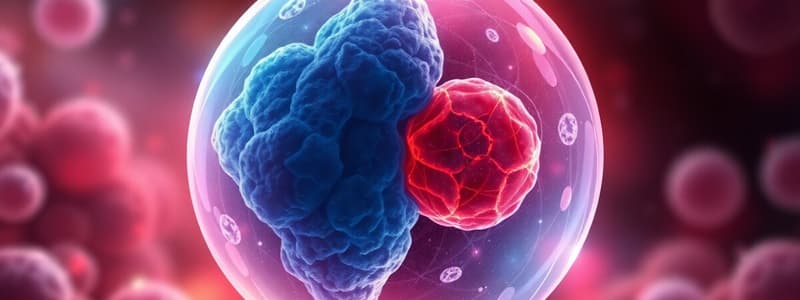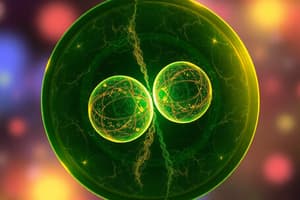Podcast
Questions and Answers
Which statement is true regarding the outcome of mitosis?
Which statement is true regarding the outcome of mitosis?
- Creates four unique daughter cells
- Involves two rounds of cell division
- Produces gametes with half the chromosome number
- Results in two identical daughter cells (correct)
What is a characteristic of meiosis?
What is a characteristic of meiosis?
- Results in two daughter cells with genetic diversity
- Results in four unique daughter cells (correct)
- Creates daughter cells for growth and repair
- Goes through one cell division to produce gametes
Which statement does NOT apply to both mitosis and meiosis?
Which statement does NOT apply to both mitosis and meiosis?
- Involves crossing over of genetic material (correct)
- Results in the division of genetic material
- Undergoes phases of cell division
- Involves the creation of new cells
Which of the following is a function of mitosis?
Which of the following is a function of mitosis?
How does the chromosome number of daughter cells compare to the parent cell in meiosis?
How does the chromosome number of daughter cells compare to the parent cell in meiosis?
What is the primary purpose of mitosis?
What is the primary purpose of mitosis?
How many daughter cells are produced through meiosis?
How many daughter cells are produced through meiosis?
Which statement accurately describes the chromosome count in the daughter cells produced by meiosis?
Which statement accurately describes the chromosome count in the daughter cells produced by meiosis?
What distinguishes the number of divisions in mitosis from that in meiosis?
What distinguishes the number of divisions in mitosis from that in meiosis?
What is the chromosome composition in the parent cell for both mitosis and meiosis?
What is the chromosome composition in the parent cell for both mitosis and meiosis?
What is the difference between homozygous and heterozygous genotypes?
What is the difference between homozygous and heterozygous genotypes?
Which process results in the formation of four new sex cells?
Which process results in the formation of four new sex cells?
Which of the following statements about alleles and phenotypes is accurate?
Which of the following statements about alleles and phenotypes is accurate?
What defines a mutation in genetics?
What defines a mutation in genetics?
In what way does mitosis differ from meiosis?
In what way does mitosis differ from meiosis?
What is the main difference in the outcome of mitosis compared to meiosis?
What is the main difference in the outcome of mitosis compared to meiosis?
During which phase of mitosis do the duplicated chromosomes align in the center of the cell?
During which phase of mitosis do the duplicated chromosomes align in the center of the cell?
What occurs during Anaphase I of meiosis?
What occurs during Anaphase I of meiosis?
Which phase of meiosis results in the formation of polar bodies in females?
Which phase of meiosis results in the formation of polar bodies in females?
How does the chromosome number in daughter cells after meiosis compare to the original cell?
How does the chromosome number in daughter cells after meiosis compare to the original cell?
Flashcards
Mitosis
Mitosis
A type of cell division that produces two identical daughter cells, each with the same number of chromosomes as the parent cell.
Meiosis
Meiosis
A type of cell division that produces four daughter cells, each with half the number of chromosomes as the parent cell. These cells are unique and are used for sexual reproduction.
Somatic Cells
Somatic Cells
All body cells except reproductive cells, such as skin, muscle, and bone cells.
Gametes
Gametes
Signup and view all the flashcards
Genetic Diversity
Genetic Diversity
Signup and view all the flashcards
Number of Divisions in Mitosis
Number of Divisions in Mitosis
Signup and view all the flashcards
Number of Divisions in Meiosis
Number of Divisions in Meiosis
Signup and view all the flashcards
Chromosomes in Daughter Cells of Mitosis
Chromosomes in Daughter Cells of Mitosis
Signup and view all the flashcards
Prophase I
Prophase I
Signup and view all the flashcards
Anaphase I
Anaphase I
Signup and view all the flashcards
Telophase I
Telophase I
Signup and view all the flashcards
Recessive Allele
Recessive Allele
Signup and view all the flashcards
Punnett Square
Punnett Square
Signup and view all the flashcards
Phenotype vs. Genotype
Phenotype vs. Genotype
Signup and view all the flashcards
Homozygous vs. Heterozygous
Homozygous vs. Heterozygous
Signup and view all the flashcards
Mutation's Effect
Mutation's Effect
Signup and view all the flashcards





